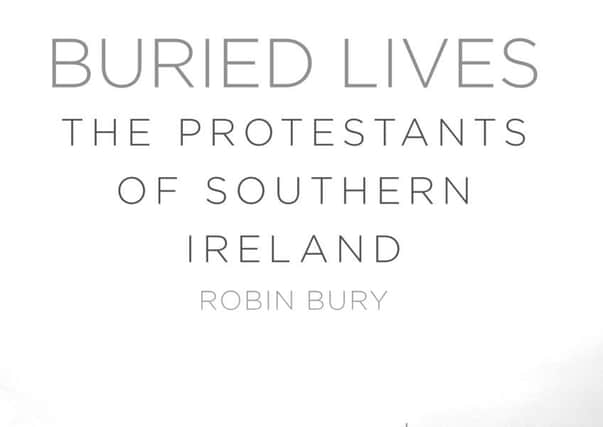How Protestants were all but ethnically cleansed in South


‘Buried Lives: The Protestants of Southern Ireland’ complements work already done by previous academics, like Peter Hart, Gerard Murphy, Marcus Tanner and others.
It comes from the pen of one who grew up, among that community, in the latter half of the 20th century, and is the product of an M.Phil thesis at Trinity College Dublin.
Advertisement
Hide AdAdvertisement
Hide AdRobin Bury helpfully divides the book into eight chapters, each dealing specifically with various aspects of the Protestant demise.
With the involuntary exodus in the period of the War of Independence and the Civil War, the author challenges some of the views previously narrated, like that of David Fitzpatrick, whom he claims relies too heavily on the records of the Methodist church.
Bury wisely relies heavily, but not exclusively, on the records of the Church of Ireland as being the largest of all the Protestant denominations that suffered the most.
Attention is drawn to the fact that The Irish Distress Committee had by the spring of 1922 to deal with some 20,000 refugees who arrived in London. Many of these were made up of disbanded members of the RIC, British ex-servicemen and civilians loyal to British regime in Ireland. Some 60,000 Protestants, not connected to the administration, left in the period 1911-1926.
Advertisement
Hide AdAdvertisement
Hide AdThe personal stories of some of those affected by the lawlessness of the period are recounted in detail. The murder, disappearances, eviction, intimidation, arson, land seizures, looting and boycotting tell a sad story of the clear sectarian nature of this ethnic cleansing. This was not just an attack upon the big house Protestants, as Marcus Tanner is quoted as stating – “practically the whole of the Protestant working-class – perhaps 10,000 – fled from Dublin in the early 1920s”. Similar tactics were used by the IRA towards the end of the 20th century.
The record of IRA burning of many of the Irish big houses is covered with some personal sorrow to the author, as many of his ancestors suffered from the looting and pillage. As the author states, much of the country’s finest architecture went up in flames during the Troubles and the Civil War.
As the flames of the Civil War died down Anglophobia persisted. This left the Protestant minority with the sense of being ‘homeless at home’. The American poet Richard Tillinghast is quoted: “... the new nation, defining itself as Gaelic, Catholic, and Nationalist, became anti-intellectual and inward looking to a pathological degree.”
When Irish became compulsory for school children, many Protestants resented this greatly, as it was used as a weapon not just to advance a Gaelic nationalism but was ‘a denial of intellectual freedom’. The author informs us that the Archbishops of Dublin, Simms and Caird, ‘spoke Irish fluently and were enthusiastic supporters of the language’.
Advertisement
Hide AdAdvertisement
Hide AdHe does not, however, tell us of their attitude towards the compulsory learning of the language.
By making Irish compulsory for public appointments it eventually discriminated against the remaining Protestant minority.
We are reminded that in this period, following the Belfast riots of 1935, there were widespread outrages against Protestants in 19 of the 26 counties of the Free State.
These events, along with the 1937 Constitution and the refusal of government ministers to enter a Protestant church for the funeral of their President Douglas Hyde, further added to a sense of not belonging. It is little wonder that this is the period when southern Protestants simply ‘kept their heads down’.
Advertisement
Hide AdAdvertisement
Hide AdThe imposition of the Ne Tempere decree and some of its disastrous results are also covered. The author states: “The Ne Temere decree played a major role in reducing Protestant numbers for a large part of the 20th century. In fact, it was the most important factor in reducing Protestant numbers post-independence in 1922.”
Bury deals with the Tilson case of 1950, as well as a details of the events in Fethard-on- Sea in the latter part of the 1950s. We should be grateful to the author, who criticises the silence of Church of Ireland bishops and the political leadership of the day, for placing these details before us.
It is recognised that, at least on the surface, things have changed for southern Protestants, particularly since the Belfast Agreement, and the changes which were required to bring that about.
On interviewing some Protestants, however, in recent years things appear very different in reality. While some are more comfortable, many give examples of the subtle kind of discrimination which is often difficult to pin down. The ‘Triumph of Intolerance’, over the postponement of the Orange Parade in Dublin in 2000 is cited as how things have changed so little in practice.
Advertisement
Hide AdAdvertisement
Hide AdDue acknowledgement is made to those who worked to make the southern state more acceptable to the Protestant minority; equally, criticism is laid at the door of those failed to deliver. The forced closure of Protestant churches in Dublin to mark the centenary of the Easter Rebellion was particularly hurtful.
This book adds greatly to the corpus of work on this period coming into the public domain in recent years. I hope that, by reminding us of these terrible atrocities of the past, it will play a significant part in how we approach the centenary of some of these events, which fall into the ‘decade of centenaries’.
• Brian Kennaway is the author of ‘The Orange Order: A Tradition Betrayed’.
• Buried Lives: The Protestants of Southern Ireland is published by The History Press, £17.99.